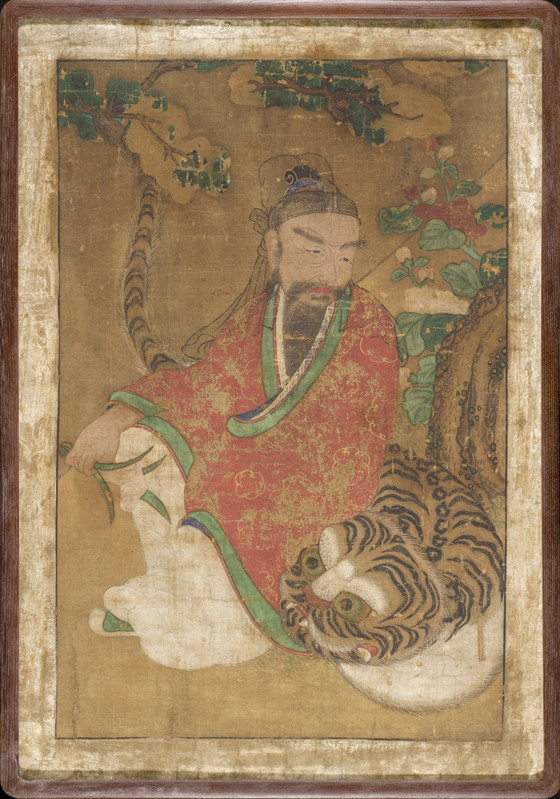Most Korean temples are located on mountains and are constructed in such a way that as visitors go further inside the temple, the higher they must climb....
Most Korean temples are located on mountains and are constructed in such a way that as visitors go further inside the temple, the higher they must climb. The altar for the mountain god (sansin) is found in the temple’s highest spot. Since the mountain god is only distantly related to the deities in the traditional Buddhist religion – such as Buddhas and bodhisattvas – it is unclear why he would require a separate altar in the temple. It could be that followers built the high altar hoping that the god, from his lofty vantage point, would be better able to protect the temple from natural disasters.
Here, the mountain god sits underneath a tree, resting his left elbow on a tiger as he looks at it with an expression of gentleness. He has a long beard, and he wears a transparent skullcap (tanggeon) and a woven-horsehair hair band (manggeon) (det. 1). His downward-slanting eyes and lips give him the appearance of an elderly scholar. In his right hand, the mountain god holds what looks like Yeoungji mushrooms with stalks of grass (det. 2). Yeoungji mushrooms not only had medicinal properties but were thought to be Bulocho, a mystical plant that granted eternal youth; mountain gods were believed to possess these plants of immortality.[1]
The tiger encircles the mountain god, and it turns its head to look at the Bulocho he is holding. This tiger’s round face, wide-open eyes, and smiling lips give him a friendly expression, contributing to the genial atmosphere of the painting. Although wild tigers are no longer found in present-day Korea, there were many in the past; tigers were believed to possess supernatural powers, and rituals were performed for them.
The composition of this painting is harmonious and well balanced, with a good use of space, making it one of the more distinctive Joseon dynasty paintings of a mountain god. Unfortunately, there has been much pigment loss on the robe and the pine needles. While the exact date of the painting is unknown, its composition places it safely within the mid-nineteenth century, when more naturalistic arrangements of the mountain god with a tiger began to appear. Another very similar painting depicting a mountain god, dated 1873, is in the Munsu Temple, North Gyeongsang province (fig. 1).
Footnotes
[1] According to the Records of the Grand Historian, also known as the Shiji, a Chinese history written by Sima Qian (司馬遷) (145-86 BC), a man named Seobok set sail in the Qin dynasty (221-206 BC) to procure the immortal plant from a god that lived on a mountain in the middle of the sea.
Bibliography
Kim, Yeongja. “The Meaning of Tiger, Background, and Other Instruments Found in Mountain God Painting [Sansindo e natanan horangyi, baegyeong, jimul ui sangjingseong].” Minsokhak yeongu 12. Seoul: Association of Korean Art History, 2003.
———. “Different Types of Mountain Gods in the Sansindo [Sansindo e pyohyeondoen sansin ui yuhyeong].” Hanguk minsokhak 41. Seoul: The Korea Folklore Society, 2005.
Yun, Yeolsu. Spirit God Paintings [Sansindo]. Seoul: Daewonsa, 1999.
———. “Types of Mountain God Painting and Women Mountain Gods [Sansindo ui yuhyeong gwa yeoseong sansindo].” Gomunhwa 53. Seoul: Korean Association of University Museums, 1999.
More...



